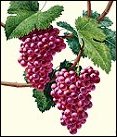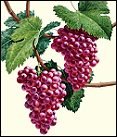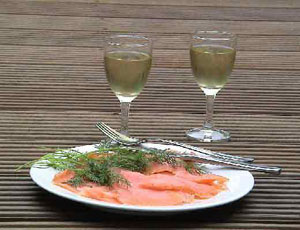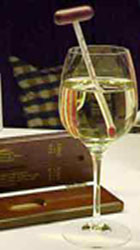 |
WINE-ADVISOR |
 |
| Home | Wine areas | Wine bottles | Wine suggestions | Wine terms | Online wine shops | Links | |
||
Wine suggestions
Below you will find a table for each wine which is the best to serve for different special occasions.
Type of Food
Red wine
White wine
Rosé wine
Sparkling wine
Appetizers
Chenin Blanc
Riesling
Sauvignon BlancWhite Grenache
White ZinfandelBlanc de Noir
Brut
Extra Dry
Spumante
ChampagneBBQ & Marinated Poultry
Zinfandel
Petit Sirah
Beaujolais
Beef
Cabernet Sauvignon
Merlot
Zinfandel
Caviar
Pinot Blanc
Blanc de Noir
Brut
Extra Dry
Spumante
ChampagneCheese (Mild)
Chenin Blanc
Gewürztraminer
Riesling
Sauvignon Blanc
SémillonWhite Grenache
White ZinfandelBlanc de Noir
Brut
Extra Dry
Spumante
ChampagneCheese (Strong)
Cabernet Sauvignon
Merlot
Pinot Noir
ZinfandelChardonnay
Blanc de Noir
Brut
Extra Dry
ChampagneDesserts
Gewürztraminer
Riesling
White Zinfandel
Spumante
Game Birds/Veal
Beaujolais
Merlot
Zinfandel
Ham
Beaujolais
Zinfandel
Pinot Noir
Gewürztraminer
Riesling
Chenin Blanc
White Zinfandel
Lamb
Cabernet Sauvignon
Merlot
Pinot Noir
Zinfandel
White Zinfandel
Pasta
Cabernet Sauvignon
Merlot
ZinfandelSauvignon Blanc
Chablis
Pinot Grigio
Riesling
Pork
Pinot Noir
Zinfandel
Chardonnay
GewürztraminerWhite Grenache
Poultry
Pinot Noir
BurgundyChardonnay
Chenin Blanc
Riesling
Sauvignon Blanc
White Zinfandel
Seafood (Heavy)
Merlot
Pinot Noir
Burgundy
Chardonnay
SémillonWhite Grenache
White Zinfandel
Seafood (Light)
Chardonnay
Gewürztraminer
Sauvignon BlancWhite Grenache
White Zinfandel
Shellfish
Chardonnay
Chenin Blanc
Riesling
Sauvignon Blanc
Sémillon
Chablis
Extra Dry
Smoked, Marinated or BBQ Beef
Cabernet Sauvignon
Merlot
Zinfandel
Tomato & Highly Seasoned Sauces
Cabernet Sauvignon
Merlot
Zinfandel
Wine temperature for serving wine
Here is a general temperature guideline for serving your wines. Please feel free to experiment !
Red wines:
Tannic red wines: 16° - 18° C / 61° to 64° F
Moderately tannic wines: 15° - 17° C / 59° to 62° F
Fruity wines, low in tannins: 13° - 15° C / 55° to 59° F
White wines:
Complex dry white wines: 10° to 13° C / 50° to 55° F
Round wine, not too heavy: 9° to 11° C / 48° to 52° F
Thin, light or sweet wine: 8° to 10° C / 46° to 50° FRosé:
8° - 10° C / 46° to 50° F
Serving a wine at a lower temperature will make you note less aroma, alcohol and bitterness and more tannins and acidity. A higher temperature will cause the opposite.
Wine and Food suggestions
Never cook with any wine you wouldn't drink. Cooking, and the process of reducing a sauce, will bring out the worst in an inferior wine.
The "cooking wine" normally found in supermarkets is generally an inferior product that would not be drunk on its own. Many not only lack distinction and flavor, but also contain additional salt.
Wine should never overpower the flavor of a dish . It should be a subtle and mysterious flavor that simply makes one want more of whatever dish it compliments. Start by adding 1 to 2 tablespoons, cook the dish for a few minutes, taste for flavor, and adjust if necessary.
In general, use dry, white wines for delicate seafood and poultry dishes.
Full-bodied red wines are better partnered with hearty meat dishes, stews and dark sauces.
To flavor soups, add a tablespoon of wine for each cup of liquid; try adding sherry to consomme, chicken or vegetable soups; Burgundy or claret go well in minestrone.
Add a light Rhine wine to melted butter and pour over fish before baking or broiling; or use to baste grilled fish.
A dash of Sauterne will improve the flavor of gravy for roast poultry, while a dash of Burgundy or Chianti adds depth to a rich gravy for duckling or goose.
Red wines add that extra flavor to beef dishes, too. Stir in Chianti or Zinfandel to gravy for roast beef, or add Chianti or Burgundy to barbecue sauce for serving with broiled or grilled beef steaks and hamburgers.
If you're serving an expensive bottle of Cabernet or Bordeaux with dinner, there's no need to cook with the same wine. Instead, choose a less expensive wine with compatible qualities.
Fortified wines contain greater amounts of alcohol (15 to 24 percent). Therefore, they have very strong flavors, so caution is the byword when adding them to food.
When preparing slow-cooking dishes like stew, add a splash of wine 20 minutes before the cooking time is finished. The flavor of wine dissipates during prolonged cooking periods, and the final addition will give it more balance.
Poaching fish in white wine gives it a delicious flavor.
Wine makes a great marinade. Combine it with other marinade ingredients, add the meat or poultry to be marinated, then cover and refrigerate overnight.
Use wine mixed with a little oil or melted butter to baste meat and poultry.
Wine is great for deglazing a pan. After food (usually meat) has been sautéed and removed from the pan, deglazing is done by adding a little wine to the pan and stirring to loosen the browned bits of food on the bottom. After cooking for a few minutes, this rich liquid can be drizzled over the cooked food, or used as a base for a sauce.
If you have a little wine left after dinner, re-cork and refrigerate it and use it the next day as part of a marinade. Or add leftover wine (up to 1 cup per quart) to vinegar for instant wine vinegar.


